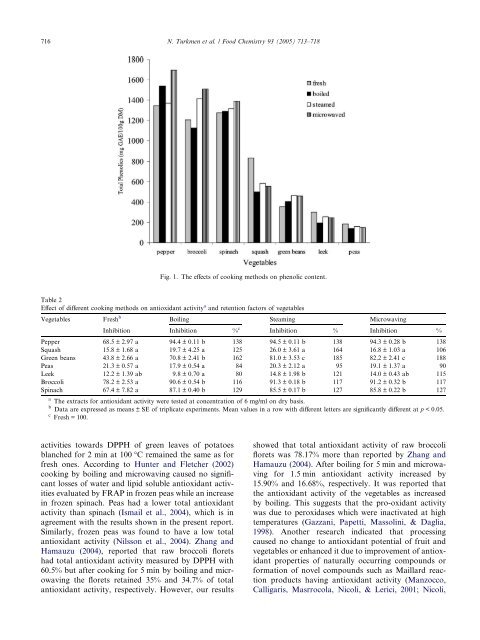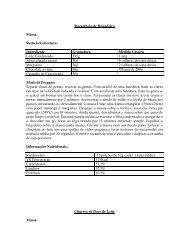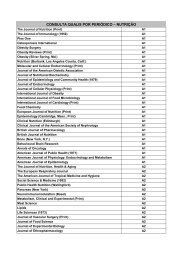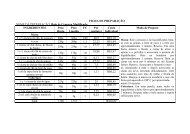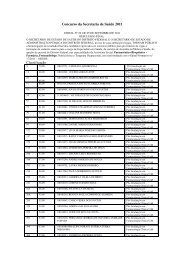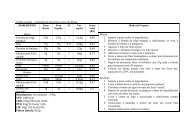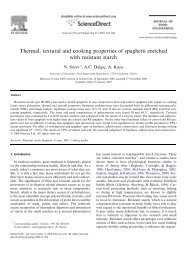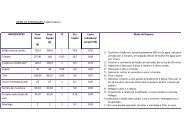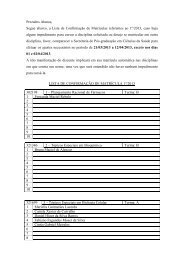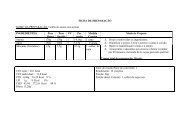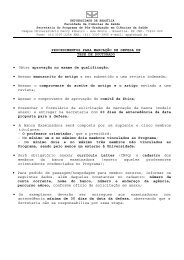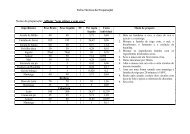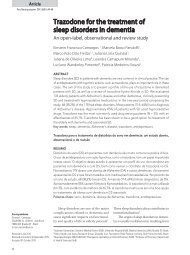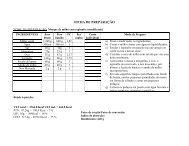716 N. Turkmen et al. / Food Chemistry 93 (2005) 713–718Fig. 1. <str<strong>on</strong>g>The</str<strong>on</strong>g> <str<strong>on</strong>g>effect</str<strong>on</strong>g>s <str<strong>on</strong>g>of</str<strong>on</strong>g> <str<strong>on</strong>g>cooking</str<strong>on</strong>g> <str<strong>on</strong>g>methods</str<strong>on</strong>g> <strong>on</strong> phenolic c<strong>on</strong>tent.Table 2Effect <str<strong>on</strong>g>of</str<strong>on</strong>g> different <str<strong>on</strong>g>cooking</str<strong>on</strong>g> <str<strong>on</strong>g>methods</str<strong>on</strong>g> <strong>on</strong> <strong>antioxidant</strong> activity a <strong>and</strong> retenti<strong>on</strong> factors <str<strong>on</strong>g>of</str<strong>on</strong>g> vegetablesVegetables Fresh b Boiling Steaming MicrowavingInhibiti<strong>on</strong> Inhibiti<strong>on</strong> % c Inhibiti<strong>on</strong> % Inhibiti<strong>on</strong> %Pepper 68.5 ± 2.97 a 94.4 ± 0.11 b 138 94.5 ± 0.11 b 138 94.3 ± 0.28 b 138Squash 15.8 ± 1.68 a 19.7 ± 4.25 a 125 26.0 ± 3.61 a 164 16.8 ± 1.03 a 106Green beans 43.8 ± 2.66 a 70.8 ± 2.41 b 162 81.0 ± 3.53 c 185 82.2 ± 2.41 c 188Peas 21.3 ± 0.57 a 17.9 ± 0.54 a 84 20.3 ± 2.12 a 95 19.1 ± 1.37 a 90Leek 12.2 ± 1.39 ab 9.8 ± 0.70 a 80 14.8 ± 1.98 b 121 14.0 ± 0.43 ab 115Broccoli 78.2 ± 2.53 a 90.6 ± 0.54 b 116 91.3 ± 0.18 b 117 91.2 ± 0.32 b 117Spinach 67.4 ± 7.82 a 87.1 ± 0.40 b 129 85.5 ± 0.17 b 127 85.8 ± 0.22 b 127a <str<strong>on</strong>g>The</str<strong>on</strong>g> extracts for <strong>antioxidant</strong> activity were tested at c<strong>on</strong>centrati<strong>on</strong> <str<strong>on</strong>g>of</str<strong>on</strong>g> 6 mg/ml <strong>on</strong> dry basis.b Data are expressed as means ± SE <str<strong>on</strong>g>of</str<strong>on</strong>g> triplicate experiments. Mean values in a row with different letters are significantly different at p < 0.05.c Fresh = 100.activities towards DPPH <str<strong>on</strong>g>of</str<strong>on</strong>g> green leaves <str<strong>on</strong>g>of</str<strong>on</strong>g> potatoesblanched for 2 min at 100 °C remained the same as forfresh <strong>on</strong>es. According to Hunter <strong>and</strong> Fletcher (2002)<str<strong>on</strong>g>cooking</str<strong>on</strong>g> by boiling <strong>and</strong> microwaving caused no significantlosses <str<strong>on</strong>g>of</str<strong>on</strong>g> water <strong>and</strong> lipid soluble <strong>antioxidant</strong> activitiesevaluated by FRAP in frozen peas while an increasein frozen spinach. Peas had a lower <strong>total</strong> <strong>antioxidant</strong>activity than spinach (Ismail et al., 2004), which is inagreement with the results shown in the present report.Similarly, frozen peas was found to have a low <strong>total</strong><strong>antioxidant</strong> activity (Nilss<strong>on</strong> et al., 2004). Zhang <strong>and</strong>Hamauzu (2004), reported that raw broccoli floretshad <strong>total</strong> <strong>antioxidant</strong> activity measured by DPPH with60.5% but after <str<strong>on</strong>g>cooking</str<strong>on</strong>g> for 5 min by boiling <strong>and</strong> microwavingthe florets retained 35% <strong>and</strong> 34.7% <str<strong>on</strong>g>of</str<strong>on</strong>g> <strong>total</strong><strong>antioxidant</strong> activity, respectively. However, our resultsshowed that <strong>total</strong> <strong>antioxidant</strong> activity <str<strong>on</strong>g>of</str<strong>on</strong>g> raw broccoliflorets was 78.17% more than reported by Zhang <strong>and</strong>Hamauzu (2004). After boiling for 5 min <strong>and</strong> microwavingfor 1.5 min <strong>antioxidant</strong> activity increased by15.90% <strong>and</strong> 16.68%, respectively. It was reported thatthe <strong>antioxidant</strong> activity <str<strong>on</strong>g>of</str<strong>on</strong>g> the vegetables as increasedby boiling. This suggests that the pro-oxidant activitywas due to peroxidases which were inactivated at hightemperatures (Gazzani, Papetti, Massolini, & Daglia,1998). Another research indicated that processingcaused no change to <strong>antioxidant</strong> potential <str<strong>on</strong>g>of</str<strong>on</strong>g> fruit <strong>and</strong>vegetables or enhanced it due to improvement <str<strong>on</strong>g>of</str<strong>on</strong>g> <strong>antioxidant</strong>properties <str<strong>on</strong>g>of</str<strong>on</strong>g> naturally occurring compounds orformati<strong>on</strong> <str<strong>on</strong>g>of</str<strong>on</strong>g> novel compounds such as Maillard reacti<strong>on</strong>products having <strong>antioxidant</strong> activity (Manzocco,Calligaris, Masrrocola, Nicoli, & Lerici, 2001; Nicoli,
N. Turkmen et al. / Food Chemistry 93 (2005) 713–718 717Fig. 2. <str<strong>on</strong>g>The</str<strong>on</strong>g> <str<strong>on</strong>g>effect</str<strong>on</strong>g>s <str<strong>on</strong>g>of</str<strong>on</strong>g> <str<strong>on</strong>g>cooking</str<strong>on</strong>g> <str<strong>on</strong>g>methods</str<strong>on</strong>g> <strong>on</strong> <strong>antioxidant</strong> activity.Anese, & Parpinel, 1999). In a study carried out byManzocco, Anese, <strong>and</strong> Nicoli (1998), pasteurisati<strong>on</strong> <str<strong>on</strong>g>of</str<strong>on</strong>g>tea extracts was found to cause an increase in <strong>antioxidant</strong>activity <str<strong>on</strong>g>of</str<strong>on</strong>g> teas, which was attributed to the formati<strong>on</strong><str<strong>on</strong>g>of</str<strong>on</strong>g> compounds having <strong>antioxidant</strong> activity duringheat treatment. Ismail et al. (2004) reported that <strong>antioxidant</strong>activities <str<strong>on</strong>g>of</str<strong>on</strong>g> the 1 min boiled vegetables were similarto the fresh <strong>on</strong>es. Giovanelli, Zan<strong>on</strong>i, Lavelli, <strong>and</strong>Nani (2002) found that <strong>antioxidant</strong> activity <str<strong>on</strong>g>of</str<strong>on</strong>g> tomatopulp <strong>and</strong> halves was not significantly different from that<str<strong>on</strong>g>of</str<strong>on</strong>g> fresh samples. This study showed that <str<strong>on</strong>g>cooking</str<strong>on</strong>g> by different<str<strong>on</strong>g>methods</str<strong>on</strong>g> enhanced <strong>antioxidant</strong> activity in broccoli,spinach, green beans <strong>and</strong> pepper <strong>and</strong> caused no changeto <strong>antioxidant</strong> activity in squash, peas <strong>and</strong> leek (Fig. 2).4. C<strong>on</strong>clusi<strong>on</strong>sAm<strong>on</strong>g green vegetables tested, pepper had the highestamount <str<strong>on</strong>g>of</str<strong>on</strong>g> <strong>phenolics</strong> <strong>and</strong> broccoli had the str<strong>on</strong>gest<strong>antioxidant</strong> activity. This study indicated that vegetablesexcept squash are rich in <strong>total</strong> <strong>phenolics</strong> showed str<strong>on</strong>g<strong>antioxidant</strong> activity at the same time. Cooking had nodeleterious <str<strong>on</strong>g>effect</str<strong>on</strong>g> <strong>on</strong> <strong>total</strong> <strong>antioxidant</strong> activity <strong>and</strong> <strong>total</strong><strong>phenolics</strong> c<strong>on</strong>tent <str<strong>on</strong>g>of</str<strong>on</strong>g> vegetables with the excepti<strong>on</strong> <str<strong>on</strong>g>of</str<strong>on</strong>g>some losses <str<strong>on</strong>g>of</str<strong>on</strong>g> <strong>phenolics</strong> in <strong>on</strong>ly squash, peas <strong>and</strong> leek.Moreover, moderate heat treatment might have beenc<strong>on</strong>sidered a useful tool in improving health properties<str<strong>on</strong>g>of</str<strong>on</strong>g> some vegetables.ReferencesAtoui, A. K., Mansouri, A., Boskou, G., & Kefalas, P. (2005). Tea <strong>and</strong>herbal infusi<strong>on</strong>s: their <strong>antioxidant</strong> activity <strong>and</strong> phenolic pr<str<strong>on</strong>g>of</str<strong>on</strong>g>ile.Food Chemistry, 89, 27–36.Chu, Y., Chang, C., & Hsu, H. (2000). Flav<strong>on</strong>oid c<strong>on</strong>tent <str<strong>on</strong>g>of</str<strong>on</strong>g> severalvegetables <strong>and</strong> their <strong>antioxidant</strong> activity. Journal <str<strong>on</strong>g>of</str<strong>on</strong>g> the Science <str<strong>on</strong>g>of</str<strong>on</strong>g>Food <strong>and</strong> Agriculture, 80, 561–566.Cheung, L. M., Cheung, P. C. K., & Ooi, V. E. C. (2003). Antioxidantactivity <strong>and</strong> <strong>total</strong> <strong>phenolics</strong> <str<strong>on</strong>g>of</str<strong>on</strong>g> edible mushroom extracts. FoodChemistry, 81, 249–255.Crozier, A., Lean, M. E. J., McD<strong>on</strong>ald, M. S., & Black, C. (1997).Quantitative analysis <str<strong>on</strong>g>of</str<strong>on</strong>g> the flav<strong>on</strong>oid c<strong>on</strong>tent <str<strong>on</strong>g>of</str<strong>on</strong>g> commercialtomatoes, <strong>on</strong>i<strong>on</strong>s, lettuce, <strong>and</strong> celery. Journal <str<strong>on</strong>g>of</str<strong>on</strong>g> Agricultural <strong>and</strong>Food Chemistry, 45, 590–595.Gazzani, G., Papetti, A., Massolini, G., & Daglia, M. (1998). Anti<strong>and</strong>prooxidant activity <str<strong>on</strong>g>of</str<strong>on</strong>g> water soluble comp<strong>on</strong>ents <str<strong>on</strong>g>of</str<strong>on</strong>g> somecomm<strong>on</strong> diet vegetables <strong>and</strong> <str<strong>on</strong>g>effect</str<strong>on</strong>g> <str<strong>on</strong>g>of</str<strong>on</strong>g> thermal treatment. Journal <str<strong>on</strong>g>of</str<strong>on</strong>g>Agricultural <strong>and</strong> Food Chemistry, 46, 4118–4122.Giovanelli, G., Zan<strong>on</strong>i, B., Lavelli, V., & Nani, R. (2002). Watersorpti<strong>on</strong>, drying <strong>and</strong> <strong>antioxidant</strong> properties <str<strong>on</strong>g>of</str<strong>on</strong>g> dried tomatoproducts. Journal <str<strong>on</strong>g>of</str<strong>on</strong>g> Food Engineering, 52, 135–141.Heim, K. E., Tagliaferro, A. R., & Bobilya, D. J. (2002). Flav<strong>on</strong>oid<strong>antioxidant</strong>: chemistry, metabolism <strong>and</strong> structure–activity relati<strong>on</strong>ships.Journal <str<strong>on</strong>g>of</str<strong>on</strong>g> Nutriti<strong>on</strong>al Biochemistry, 13, 572–584.Hunter, K. J., & Fletcher, J. M. (2002). <str<strong>on</strong>g>The</str<strong>on</strong>g> <strong>antioxidant</strong> activity<strong>and</strong> compositi<strong>on</strong> <str<strong>on</strong>g>of</str<strong>on</strong>g> fresh, frozen, jarred <strong>and</strong> canned vegetables.Innovative Food Science <strong>and</strong> Emerging Technologies, 3,399–406.Ismail, A., Marjan, Z. M., & Fo<strong>on</strong>g, C. W. (2004). Total <strong>antioxidant</strong>activity <strong>and</strong> phenolic c<strong>on</strong>tent in selected vegetables. Food Chemistry,87, 581–586.Lopaczynski, W., & Zeisel, S. H. (2001). Antioxidants, programmedcell death, <strong>and</strong> cancer. Nutriti<strong>on</strong> Research, 21, 295–307.


